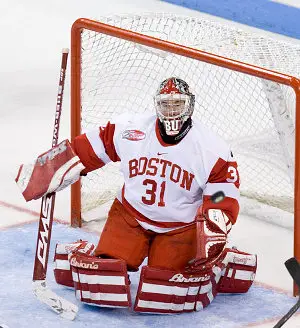Scott: Jim, the second half is getting under way, but perhaps we should start with a review of the holiday tournaments. It was spread-the-wealth time the last two weeks, with the CCHA and ECAC Hockey each winning three tournaments and Hockey East and the WCHA two apiece. In my estimation, the most notable results were Boston University storming through the Denver Cup en route to a 4-1 title-game win over the host Pioneers and Miami taking it on the chin at the Ohio Hockey Classic, losing both its games to Clarkson and then Army. The Black Knights, who had a terrible first half, have to be elated with their 3-2 win over the then-No. 2 RedHawks, though most of the credit goes to goaltender Jay Clark for his amazing total of 56 saves. Your thoughts?

Jim: Well, first thought, Scotty, is that Miami should spend all week practicing burying the puck — not just almost burying it. You can run into a hot goaltender or two, but Miami scored just four goals on 110 shots over the weekend. Seriously, if you’re generating that many shots, you have to figure out what your team isn’t doing right. As for the rest of the holiday tournament action, I thought much of it was business as usual. All of the tournaments except the UConn Classic (won by Quinnipiac), were won by clubs that are ranked in the top 20 of the USCHO.com/CBS College Sports poll. The only top team to lose was Denver, and as you mentioned the Pioneers got buzzsawed by a BU team that improved to 7-0 in non-conference play and dominated its opposition, outscoring them, 10-3, on the weekend. The one team I do want to highlight is Cornell. In the Florida College Classic, the Big Red came out victors after facing a very good St. Cloud team and a Colgate club that I feel is just a dose of confidence away from being a solid second-half team. I have to believe that Cornell, with just one loss, is one of the top teams in the nation.
Scott: Jim, I think you might be right about Cornell. The Big Red have had a couple of tough seasons, but it hasn’t been that long since Mike Schafer’s crew was the dominant force in ECAC Hockey, winning three regular-season titles, two tournament championships and making four NCAA tournaments in five years from 2002 to 2006, including a Frozen Four appearance in 2003 when the Big Red won 30 games. This year, it’s the usual story for Cornell hockey — tough D (second nationally in scoring defense) backstopped by often-outrageous goaltending from Ben Scrivens, who’s putting up the kind of numbers that would have been unthinkable just a decade ago and even now is second in the country in goals against average and save percentage. And the PairWise Rankings — which USCHO.com debuted today — agree. Cornell is No. 1 in the PWR, with the top Ratings Percentage Index backing it up.
Jim: Your point about Scrivens is well-made. He was definitely the deciding factor two weekends ago down in Estero. St. Cloud outskated the Big Red and Scrivens made some incredible saves. In the title game, he held the fort when Colgate grabbed a 2-0 lead, allowed his team to knot the game at 2 and then pitched a shutout in the shootout. Now that I’ve had a chance to look at the PairWise, I may be a little surprised at the fact that Cornell is No. 1, but that’s hardly my biggest surprise. Vermont ranking in at No. 4 definitely opens my eyes. I’ve believed that Catamounts are good but didn’t know they were that good. Maine’s another team sitting square on the bubble at No. 15. Right now, there’s an interesting conference breakdown: Hockey East 5, CCHA 4, ECAC 3, WCHA 2, AHA/CHA 1 each. The WCHA with two teams. Christ, I can hear the uproar from just west of the Mississippi now. Funny thing is, the bubble teams are Maine, Quinnipiac and Air Force, so things don’t immediately get any better for the “W.” Is this the sign of the college hockey apocalypse?
Scott: Out here it may well be, although the signs have been there all season. We’ve discussed Hockey East’s dominance previously, and there it is in black and white. The WCHA’s saving grace is that it has no fewer than six teams ranked between 18 and 25 in the PWR, most of them with records at or just above .500. WCHA loyalists might claim that that’s the byproduct of the league beating up on itself, but that explanation doesn’t fly with the PairWise. The simple fact is that interleague play is how the PWR figures out the strengths of the various conferences, and the WCHA hasn’t been particularly strong in that category this year. Now, do I think the WCHA is only going to get two teams into the NCAAs? Not by a long shot. One or more of those squads currently lurking in the lower reaches of the rankings will get hot and climb in the numbers, and there’s always the possibility of an upset tournament champion making the nationals if the WCHA field is still thin in March. You heard it here first — I’m predicting four WCHA teams in the field of 16 come season’s end, second to Hockey East’s five. How’s that for an early (and therefore meaningless) prognostication?
Jim: Bold, Scotty. Bold. I think I feel comfortable taking the other side of this pillow. I believe that the WCHA will get three or less teams into the tournament. Is this a bet we should take to the bank? Likely not for either one of us. And speaking of bets, I have to say that I would’ve bet the farm that the United States would be able to get past Slovakia in the quarterfinals of the World Junior Championship. But yet again, the Americans were denied. The U.S. seemed out of sorts that entire game, which may have been a byproduct of blowing a three-goal lead in the final preliminary round game versus Canada. At this point, you have to feel that the World Junior monkey, which seemed off the U.S. backs when they won the tournament in 2004, may have climbed back on.
Scott: I didn’t see the game, but I was at Mariucci Arena when the result came over the PA system, and the universal reaction among the media types was head-shaking dismay. I understand the problem of running into a hot goaltender — which Jaroslav Janus was for Slovakia — but that explanation only works when you lose a game 2-1, not when you give up five goals to a team you should beat. This result was particularly baffling given how good the U.S. team had looked in the round-robin phase (despite the costly loss against Canada, which did go on to win the gold medal). The other thing I couldn’t figure out was how Minnesota’s Jordan Schroeder led the team in points and still didn’t get named among the top three players for the U.S., but then again, I wasn’t there. At least Schroeder, a freshman, will have another chance next year assuming he’s selected for the WJC again. Back on college ice, it’s full speed ahead this weekend as the schedule resumes in earnest. I’ll be especially interested in the Miami-Michigan series given the last two weeks’ results, and in Minnesota’s games at North Dakota without head coach Don Lucia, whose health has become a topic of interest in the last week or so.
Jim: We’ve talked a little about Miami, so I’ll focus on Minnesota and head coach Don Lucia. The good news from last weekend seemed to be the fact that he was at Mariucci on Saturday night and able to address the media. I personally can’t imagine being in a position where I’m not sure of my own health. That unsettled feeling that accompanies is certainly enough to distract anyone, let alone a coach whose responsibility is to guide his team on the ice. I think he made a good move in stepping aside temporarily. Though I’d usually end things here, I think seeing as you spend so much time around Coach Lucia that it’s appropriate for you to add your thoughts and close out this week’s column.
Scott: Well, most of what I know got turned into the news story we’re running, but the situation appears to be that no one knows exactly what’s wrong with Lucia yet, or if they do they’re not telling, and more tests are scheduled. When I saw him at Mariucci Saturday both in the press box and downstairs during his comments, he didn’t look unwell in an obvious way, but that means nothing, of course — you can be seriously ill and not show it on your face or in your bearing. So I simply wish him the best, and I’ll do the same for you until next week…


